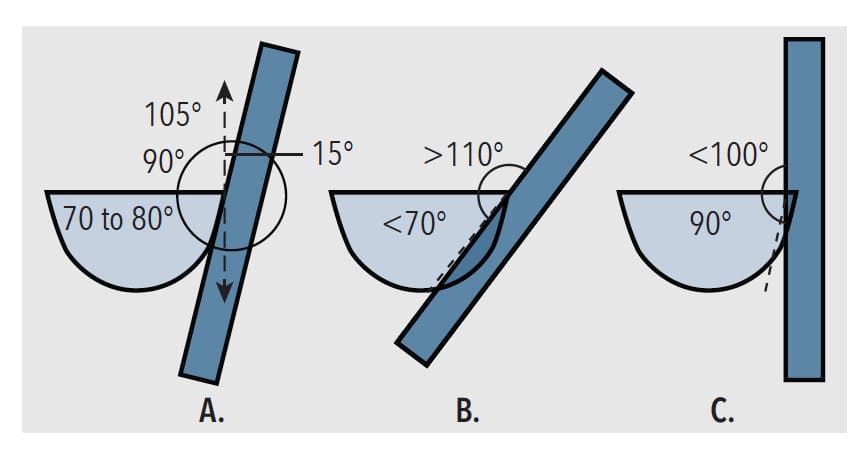How to Keep Instruments Sharp
I am spending lots of time sharpening my instruments. What can I do to help them stay sharp longer?
I am spending lots of time sharpening my instruments. What can I do to help them stay sharp longer?
There are two basic sharpening objectives: to produce a sharp cutting edge and to maintain the original contour of the instrument. The optimal internal angle of an instrument face to its lateral surface is 70° to 80º. To maintain this internal angle, the sharpening stone is placed on the lateral surface at a 100° to 110º angle to the face of the instrument (Figure 1). To evaluate this angle, use direct vision with magnification and excellent lighting, use a protractor, or apply a guide manufactured by an instrument company. If the stone is placed at an angle greater than 110º to the instrument face, an internal angle will be created that is less than 70º. The result can be a sharp cutting edge; however, the internal angle is too acute and the sharp cutting edge is thin. Therefore, the instrument will dull very quickly. If a sharp blade only lasts five scaling strokes to 20 scaling strokes before becoming dull, this error might be the problem. If the stone-to-face angle is less than 100º, an almost 90º internal instrument angle will be created. Therefore, the instrument will be dull. This nonfunctioning cutting edge will require sharpening again very quickly. A dull instrument causes burnished calculus, increased lateral pressure, inefficiency, frustration for the clinician, and discomfort for both patients and clinicians.

Both of these scenarios change the ideal 70° to 80º internal angle and can create bevels on the cutting edge. These changes make it more difficult to return the instrument to its original shape. Recontouring will then be needed, which is more time consuming than routine maintenance sharpening.
To evaluate instrument sharpness, use a test stick, visually observe the cutting edge with magnification, and listen for the sound of the cutting edge against the tooth. A sharp edge placed at a similar angle to scaling (about 75º) will “bite” the test stick. A sharp edge will not reflect light; a dull edge reflects light due to the flat bevel that appears shiny.
Use of the stationary instrument, movable stone technique is advisable to visualize the important angles. Also, use a fine grit stone for routine maintenance. An abrasive stone will remove too much metal when used often. Brace the instrument against a stationary object in your nondominant hand with a palm grasp. Your dominant hand holding the stone should be close to your body. Also, the face of an instrument should be positioned parallel to the floor. Ensure the stone remains at the same angle to the instrument face as it is activated in up and down vertical motions. Proceed from the heel to the toe of the instrument sharpening one section at a time to maintain the original blade shape and sharpen the entire cutting edge.
To self-assess, observe your skills in a relaxed environment such as before or after a work day. You can also ask another dental hygienist to observe your sharpening and provide feedback, attend a continuing education course, read journal articles and dental hygiene textbooks, review a reputable video, and/or view an online webinar. Also, consider purchasing instruments made with a stainless steel alloy that stay sharper for longer periods of time.
From Dimensions of Dental Hygiene. October 2022; 20(10)46.

